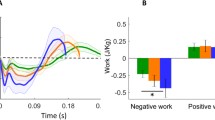Abstract
During running, the behaviour of the support leg was studied by modelling the runner using an oscillating system composed of a spring (the leg) and of a mass (the body mass). This model was applied to eight middle-distance runners running on a level treadmill at a velocity corresponding to 90% of their maximal aerobic velocity [mean 5.10 (SD 0.33) m · s−1]. Their energy cost of running (C r ), was determined from the measurement of O2 consumption. The work, the stiffness and the resonant frequency of both legs were computed from measurements performed with a kinematic arm. The C r was significantly related to the stiffness (P < 0.05, r = −0.80) and the absolute difference between the resonant frequency and the step frequency (P < 0.05, r = 0.79) computed for the leg producing the highest positive work. Neither of these significant relationships were obtained when analysing data from the other leg probably because of the work asymmetry observed between legs. It was concluded that the spring-mass model is a good approach further to understand mechanisms underlying the interindividual differences in C r .
Similar content being viewed by others
Author information
Authors and Affiliations
Additional information
Accepted: 18 August 1997
Rights and permissions
About this article
Cite this article
Dalleau, G., Belli, A., Bourdin, M. et al. The spring-mass model and the energy cost of treadmill running. Eur J Appl Physiol 77, 257–263 (1998). https://doi.org/10.1007/s004210050330
Issue Date:
DOI: https://doi.org/10.1007/s004210050330



